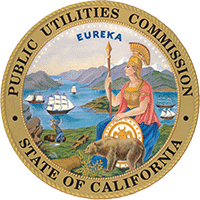Load Impact Protocols
Load Impact Protocols
The Load Impact Protocols (LIPs) are used to estimate ex-ante Qualifying Capacity (QC) and establish RA-eligible QC for DR resources. The LIPs were adopted by D.08-04-050, which prescribes a set of guidelines for estimating the load impact (or load change) resulting from DR activities. These guidelines established a consistent method for measuring program performance across DR resources on ex-post basis and for forecasting anticipated performance (or available capacity) on ex-ante basis. Additionally, the resulting capacity estimates are used to analyze the cost-effectiveness of DR programs managed by the IOUs and for other CPUC activities such as the RA framework and long-term integrated resource planning.
Important Resources
The Load Impact Protocol Filing Guide is the master document Energy Division releases about annually to provide guidance on the LIP process and filing requirements. The most recent iteration is version 5.1 released 12/31/2024.
Relevant templates for LIPs:
- Quarterly Dispatch Test Reports v2 (updated 12/19/2024)
- April Qualifying Capacity Updates
- July Qualifying Capacity Updates
- DR Month-Ahead NQC Supply Plan (Slice of Day Template) - updated 11/3/2024
Below are the peak hours as projected by the California Energy Commission in their 2024 California Energy Demand. These are provided as a courtesy. DRPs, when filing NQC requests, are still required to use the most up-to-date peak hours.
| Year (Hour Ending) | Jan | Feb | Mar | Apr | May | Jun | Jul | Aug | Sept | Oct | Nov | Dec |
| 2025 | 19 | 19 | 19 | 19 | 20 | 18 | 17 | 18 | 17 | 17 | 18 | 18 |
| 2026 | 19 | 19 | 19 | 19 | 20 | 18 | 17 | 18 | 17 | 17 | 18 | 18 |
| 2027* | 19 | 19 | 19 | 19 | 20 | 18 | 18 | 18 | 18 | 18 | 18 | 18 |
| 2028 | 19 | 8 | 19 | 19 | 20 | 18 | 18 | 18 | 18 | 18 | 18 | 19 |
| 2029 | 8 | 8 | 19 | 19 | 20 | 18 | 18 | 18 | 18 | 18 | 18 | 8 |
| 2030 | 8 | 8 | 19 | 19 | 19 | 18 | 18 | 18 | 18 | 18 | 18 | 8 |
*For filing year 2026 for RA year 2027, only use peak hours from 2027 in this chart for ex ante LIP filings.
Historical LIP reports are archived at California Measurement Advisory Council: CALMAC.
The Demand Response Measurement and Evaluation Committee (DRMEC)—with members from CPUC, California Energy Commission, and the three IOUs—is responsible for running the annual LIP workshops. Slides can be found here.
Legislative History of LIPs
-
D.08-04-050: established the annual LIP process.
-
Attachment A: All original 27 protocols.
-
D.10-04-006 Ordering Paragraphs (OP) 1-2: established Investor-Owned Utility (IOU) Executive Summary Requirement in Appendix 1
-
D.10-06-036 OP 10: established 5-hr window “measurement hours” from LIP ex ante to determine monthly Qualifying Capacity (QC) of Demand Response (DR) resource according to protocols 17, 21, 22, 23.
-
Also made numerous line-item changes to protocols, including removing uncertainty adjustments from table generators, which type of ex post days are required, eliminating 1-in-10 weather year, when an evaluation plan is needed, and other clarifications.
-
D.16-06-045 OP 5a: exempted third-party DR resources from LIPs and allowed the use of contracted capacity to be resource adequacy (RA) QC.
-
D.19-06-026 OP 17: acknowledged expiration of exemption authorized in D.16-06-045.
-
OP 13-14: established 3rd-party Demand Response Provider (DRP) quarterly testing requirements.
-
OP 15a: clarified 3rd-party DRP ex post and ex ante must be estimated at Sub-LAP.
-
OP 15b: permitted mid-year QC updates if QC values vary by >20% of 10 MW, whichever is greater.
-
OP 16: directed ED to coordinate with supply-side working group on mid-year QC process/requirements and how to enhance LIPs.
-
OP 17: requires LIP results from 3rd party DRPs to be public to the maximum extent allowable, while protecting customer privacy and market sensitive information.
-
OP 12: modified quarterly testing requirements for third-party DRPs for RA-year 2023. Established RA-year 2024 as test year.
-
Appendix A established “worst day” criterion instead of “peak day” for RA QC and 24-hour slice-of-day framework.
-
D.22-08-039: LIPs were reasonable to use for slice-of-day test year.
-
D.23-04-010 OP 11-12: established slice-of-day requirements, including snapback effect requirements in ex ante.
-
OP 27: removed transmission loss factor and planning reserve margin adders starting in 2024.
-
OP 30: required quarterly testing reports to be factored into RA QC award considerations.
-
D.24-12-003: OP 7 & Section 4.6 discussed and adopted a majority of the recommendations from the Load Impact Protocol Simplification Working Group Report.
-
Appendix C has all the redlined adopted changes to the LIPs as recommended by the WG.
Load Impact Protocol Simplification Working Group
In Decision (D.) 23-06-029 in R.21-10-002, the CPUC authorized Energy Division to conduct a stakeholder process to pursue simplification of the current LIPs. The working group met from July 2023 through January 2024, ultimately submitting a report to the commission in R.23-10-011 for consideration in Phase II. The full WG report can be found below:
